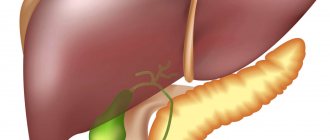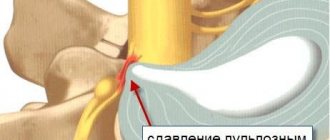| Optic neuritis | |
| ICD-10 | 46.046.0 |
| DiseasesDB | 9242 |
| MedlinePlus | 000741 |
| MeSH | D009902 and D009902 |
Optic neuritis
(
lat. “-itis” - “inflammation”
) is a primary inflammation of the optic nerve (second cranial nerve). The most common cause is demyelinating disease of the central nervous system. Other causes may be progressive meningitis, inflammation of the contents of the orbit, sinusitis (especially the posterior ethmoid cells). When the papilla of the nerve is involved in inflammation of the optic nerve, it is called papillitis. When the nipple is not affected, the disease is often also called retrobulbar neuritis. For a long time, demyelination was considered the main pathogenesis of optic neuritis. Since the 2000s, there has been more and more talk about the destruction of axons and neurons as primary factors in the development of the process. The cause of this neurodegenerative process is unclear.
Causes
- Neuritis develops against a background that affects the eye orbits.
- The pathology may be associated with brain diseases (encephalitis, meningitis).
- There are often cases when neuritis occurs as a result of tonsillitis or sinusitis.
- Pathology can develop in a person who has suffered an infectious disease.
- In rare cases, neuritis occurs during complicated pregnancy.
- The cause may be an autoimmune disorder, endocrine disease (diabetes).
Diagnosis and treatment of inflammation of the optic nerve
Symptoms such as impaired eye movement and visual disturbances are already very clear signs of optic nerve disease.
To be able to determine the inflammation of this, the attending physician first makes an appointment by telephone. First of all, questions are asked about possible pre-existing diseases and symptoms, as well as their temporary occurrence. Subsequently, ophthalmologists usually check the patient's pupillary response and visual acuity. Based on fundoscopy, in which the fundus of the eye is carefully illuminated with an ophthalmoscope, the results can be definitively confirmed. The concept of “Neuritis” characterizes the inflammatory process in the optic nerve.
This disease causes swelling (a symptom that causes the optic fibers to become compressed and subsequently undergo degenerative changes). Pathological reactions affect visual acuity: it decreases gradually. When the symptoms subside, the fibers begin to recover and vision improves.
Inflammation of the optic nerve - course, complications and prevention
Depending on the specific cause, optic nerve inflammation can then be treated as follows. For this special treatment, so-called immunosuppressants are used, which include steroidal glucocorticoids such as cortisone or methylprednisolone. Likewise, infections and injuries to the eye should be treated with medications, such as taking antibiotics. Eye-Friendly Herbs: In addition to eye girth, there are many other medicinal herbs that provide eye inflammation relief. These include, for example, dill, marshmallows, potatoes, dogfish, toad, radish and centaurs. As a relaxing eye wrap or tea, medicinal plants help neutralize inflammatory stimuli and also relieve pain from strained eyes. Ease of the eye: mainly for patients with inflammation of the optic nerve, protect the eyes as best as possible. For eyes, strenuous activities such as looking at a screen or seeing in too bright lighting conditions, you should pause for a while. In general, closing the eyes in combination with bed sheets can aid the healing process. The healing process of retrobulbar neuritis and papillitis differs greatly in duration. However, treatment usually takes 3 to 4 weeks, provided the optic nerve inflammation is detected and treated promptly. About 70% of all patients with new-onset retrobulbar neuritis regain full vision with early treatment. Papillitis, on the other hand, often develops creepingly and can mean a lasting, albeit minor, loss of income until it is discovered. In general, when the optic nerve becomes inflamed, complications should be expected, which means vision impairment. However, autoimmune nerve diseases can hardly be avoided as a cause, so only conscientious treatment of the disease can prevent inflammation of the optic nerve here. Optic neuritis can occur in different shapes and forms.
Types of disease
The classification depends on what causes optic neuritis. Several types of pathology can be distinguished:
- ischemic;
- autoimmune;
- infectious;
- toxic.
The cause of ischemic neuritis is stroke. Symptoms of toxic neuritis can appear in people who have been poisoned with methyl alcohol. Intrabulbar neuritis is characterized by changes in the optic nerve head.
Either way, vision is seriously compromised. This results in symptoms such as impaired eye movements or limited perception of color and contrast. However, timely and comprehensive treatment in most cases can completely eliminate APE. Vision loss either returns completely or there is only minimal ocular dysfunction. To avoid complications during treatment, you should consult an ophthalmologist if you suspect NOP.
What is inflammation of the optic nerve?
This can begin as early as possible with suitable and professional therapy. It often occurs as an early symptom of multiple sclerosis, but also occurs without this underlying disease. After inflammation of the optic nerve, some optic nerve atrophy may be left with limited visual acuity.
Children often suffer from the disease. Retrobulbar neuritis occurs when the optic nerve becomes damaged and moves out of the orbit. This form of pathology is associated with multiple sclerosis. If an ophthalmoscopy is performed during retrobulbar neuritis, the disorder may not be detected.
Symptomatic manifestations
All the main symptoms of the disease are associated with vision loss. Vision loss can be partial or complete, and sometimes so-called “foggy” vision occurs, when the picture suddenly becomes blurry. The main symptoms were described above; inflammation of the optic nerve can be accompanied by pain during motor activity of the eye.
As for the early symptoms, they are associated with the symptoms of multiple sclerosis - blurred vision, eye twitching, lack of coordination, and others. As soon as periodic “blurry vision” occurs, this is a signal to contact a doctor in order to stop the disease at its very beginning and prevent further loss of vision.
Photophobia, redness of the eyes, and deterioration of night vision are also considered early symptoms. Some patients complain of a change in the perception of colors; the red spectrum often disappears. Sometimes deterioration of vision is accompanied by an increase in temperature. In half of the cases in adults, only one eye is affected, but in children, bilateral damage is more common.
Symptoms
Intrabulbar neuritis
The disease has a pronounced clinical picture. A person's vision noticeably deteriorates. The nature of the disturbance depends on how much the optic nerve is affected. If a total process takes place, blindness may occur. With intrabulbar neuritis, spots appear in the field of vision. They have different shapes.
Optic nerve inflammation is an autoimmune inflammation of the second cranial nerve. First, there is damage to the myelin sheath, which electrically insulates the nerve and allows for high nerve conduction velocity. In a progressive course, the actual nerve fibers suffer from inflammation and may die.
This is a so-called demyelinating disease, in which the myelin sheaths are destroyed by chronic inflammation throughout the central nervous system. Inflammation of the optic nerve usually appears between them. The incidence of the disease is about 3 out of every 000 people. Women are three to four times more likely to be affected than men.
A symptom of progressive intrabulbar neuritis is a decrease in shade perception. Adaptive capabilities deteriorate in the dark.
A characteristic sign of intrabulbar neuritis is swelling. The vessels are moderately dilated. Duration of such symptoms: 4 - 5 weeks. After this time, the swelling goes away and the hemorrhage resolves. If intrabulbar neuritis is severe, the optic nerve atrophies. During ophthalmoscopy, a pale disc is revealed, the vessels of which are narrowed.
Reduce contrast and color. . The first symptom of inflammation of the optic nerve is the rapid onset of loss of visual acuity. Mild pain or pressure when moving the eyes. Headaches and flashes of light often occur. Also typical is a temporary exacerbation of symptoms of elevated body temperature, for example. In extreme cases, it can lead to complete blindness. In 7% of cases, inflammation of the optic nerve occurs on both sides.
Ophthalmic examination of the fundus may not be noticeable; Only in 35% of cases is a swollen papilla observed. Electrophysiological conductors may detect decreased nerve conduction velocity. Otherwise, optic nerve inflammation is diagnosed solely on the basis of its clinical symptoms and typical course. After a rapid onset, inflammation usually lasts 1-2 weeks, followed by spontaneous remission. No improvement is expected after 5 weeks. The extent of residual damage depends on how inflammation has already affected the optic nerve axons.
Retrobulbar neuritis
This form of the disease occurs in different ways. Axial inflammation manifests itself as a disturbance in central vision. The damage affects the deep layers of the nerve. The patient experiences pain in the eye, which intensifies when moving the eyeballs. With the transversal form of retrobulbar neuritis, the optic nerve tissue is affected. The pathology can lead to complete loss of vision. With transversal neuritis, a gradual decrease in visual acuity is observed.
Because while myelin sheaths can regenerate, axons are usually irreparable. 95% of those affected achieve a visual acuity of at least 0. After treatment, 70% even regain a visual acuity of at least 1 after controlled inflammation of the optic nerve.
Relative frequency per 000 inhabitants per federal state. The most dangerous complication of inflammation of the optic nerve is complete blindness of the patient. In general, visual acuity quickly deteriorates with inflammation of the optic nerve. This increases the risk of accidents and falls in daily life and work life. If the inflammation spreads to other parts of the body, it can lead to infection in the nasopharynx, middle ear infection and rarely skin irritation with itching, swelling and redness.
The course of retrobulbar neuritis is not characterized by changes in the optic nerve head.
Possible complications
Neuritis can lead to the following consequences:
Other complications depend on the cause of the inflammation. If the symptoms are based on multiple sclerosis, it inevitably leads to vision loss. Retrobulbar neuritis can sometimes cause severe eye pain and temporary vision problems. Treating optic nerve inflammation also carries risks. Cortisone therapy may cause side effects such as swelling and gastrointestinal discomfort. Various symptoms may occur after taking antibiotics and antivirals, including pain in the head, neck, muscles and limbs, redness and itching, and allergic reactions.
- , in which vision decreases.
- Blindness.
Diagnostics
You need to come to see an ophthalmologist. The doctor will collect anamnesis. A differential examination will be required. Additional procedures will help determine the extent of the disease. The doctor may prescribe fundus angiography or lumbar puncture. To identify the causes of neuritis, an MRI of the brain will be required. A blood test may be needed. After passing the tests, the ophthalmologist will refer you to an infectious disease specialist.
Long-term use of these drugs will cause permanent damage to the kidneys, liver, and heart. Therefore, in consultation with the patient, disease abbreviation must be carefully weighed against the side effects of steroid therapy. With the so-called atypical inflammation of the optic nerve, which does not improve even after 4 weeks, you should think about an infectious background. If inflammation of the optic nerve is based on multiple sclerosis, it is, of course, necessary to treat the underlying disease. It cannot be cured, but can be delayed and mitigated.
Diagnostics
Diagnosis of optic neuritis is purely clinical. Two thirds of patients with optic neuritis do not show any changes in the fundus or nerve papilla. In approximately one third of patients, blurred nerve disc boundaries and a protruding nipple are found, indicating edema. The vessels are dilated, with unclear boundaries, and petechial hemorrhages are sometimes visible. Laboratory tests, including cerebrospinal fluid tests, are nonspecific. The point of performing a brain MRI or cerebrospinal fluid examination is to identify possible multiple sclerosis (MS). Visual evoked potentials can confirm the diagnosis of optic neuritis; a prolongation of the latent period is typical, which persists after remission of the disease.
Treatment
By medication
Therapy depends on the nature of the disease. It is carried out in a hospital setting.
The doctor prescribes:
- anti-inflammatory;
- metabolic;
- antibacterial;
- desensitizing drugs.
In some cases, antibiotics and corticosteroids are prescribed. Some forms of the disease require taking medications with potassium and B vitamins.
Here you will find the cure
Because neither inflammation of the optic nerve nor its underlying cause, multiple sclerosis, is fully understood, it is also unknown how to prevent the disease. To prevent inflammation of the optic nerve, you should avoid these risk factors. Inflammation of the optic nerve is also called optic neuritis. Depending on the location of the inflammation, they speak of papillitis, retrobulbar neuritis or neuroretinitis. Thus, the optic nerve is affected in cases of papillitis in the eyes and in retrobulbar neuritis behind the eye.
If a person is poisoned with methyl alcohol and develops neuritis, he needs to urgently rinse his stomach. 30% ethyl alcohol is injected internally: it is an antidote. The medicine displaces poisonous methyl alcohol.
If signs of optic nerve atrophy are detected, the doctor prescribes drugs that improve blood microcirculation.
Causes of optic neuritis
The causes of optic neuritis can be very diverse:
- Medicines used in the treatment of tuberculosis (ethambutol has the most toxic property in relation to the visual analyzer);
- Tumors of the eye and orbit;
- Poisoning with methyl alcohol and alcohol substitutes;
- Diabetes;
- Eye injuries accompanied by compression or bruising;
- Multiple sclerosis. This is a severe autoimmune disease in which myelin is destroyed. Myelin is a substance that covers a nerve and allows nerve impulses to pass through it;
- Some infectious diseases : rubella, measles, syphilis, herpes infection, Lyme disease, systemic lupus erythematosus;
- Inflammation of the intracranial arteries. Typical for elderly and senile people;
- Radiation therapy in the treatment of cancer.
conclusions
Optic neuritis is dangerous due to complications. We need to take the treatment of this disease seriously. Medicines prescribed by a doctor are taken in accordance with dosages. Self-medication of optic neuritis is unacceptable!
An acute inflammatory process in the fibers of the optic nerves, affecting visual acuity, is optic neuritis. Depending on the area of distribution of the pathological process, two types of disease are distinguished:
- Simple neuritis. This is the case when inflammation affects the optic nerve head.
- Retrobulbar optic neuritis. The process spreads mainly outside the eyeball, affecting the axial bundle of nerve fibers.











